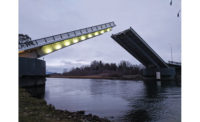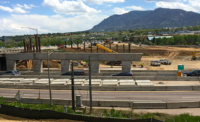Steely Determination, Design Save a California Crossing
A switch to steel and six weeks of swift redesign saved a city’s dream of a signature pedestrian crossing with a 325-ft main span over 10 lanes of Interstate 280 in Silicon Valley. The first cable-stayed crossing over a freeway in California, the city of Cupertino’s Mary Avenue Bridge seemed doomed in 2007 after a concrete design received two bids double the $6 million budget. But thanks to the city calling on key industry contacts, it is slated to open next month.

“We were in a state of depression,” says Terry Greene, the city’s architect. The city wanted a crossing across the 10-lane freeway that would reconnect bisected neighborhoods and provide a safe biking and walking alternative to a traffic-heavy bridge almost a mile away.
Greene and Ralph Qualls, the city’s public work director, turned to industry colleagues such as Les Robertson and Flatiron Construction Corp., Longmont, Colo., for advice. Consequently, they met in August 2007 with bridge designers in HNTB Corp.’s New York City office. “Ted [Zoli, HNTB director of long-span bridge design] lectured us for an hour about steel bridges,” says Qualls. “We said we need to award the job by Thanksgiving. You could hear an intake of breath.”
Determined, Qualls and his colleagues lobbied the Valley Transportation Authority and city council for $3 million more dollars, saying the steel redesign would cost only $10 million. But the design had to be done in six weeks or the money would be shifted elsewhere. “Funding was at risk, says John Litzinger, HNTB project manager. “The council was changing membership.”
Hoping to avoid another situation of too-high bids, “we decided to reach out to the contractors,” says Greene. “We had a Webcast where [Zoli] did an hour of explanations.” Zoli adds: “We had a prebid conference where instead of just saying ‘Any questions?’ we gave a complete analysis.” HNTB would also act as the contractor’s erecting engineer for the planned nine-month schedule.
“By eliminating the falsework and the expensive steel forming system for concrete towers, we probably saved $600,000,” says Tom Loomis, project executive with Swinerton Management and Consulting, a division of San Francisco-based Swinteron Inc., the construction manager. “The concrete would need two sets of falsework and forms for the columns.”
This time, five bids came in, all under the $10.2 million estimate. Golden State Bridge Inc., Martinez, Calif., won with a $7.5-million bid. The contractor used 210-ton and 90-ton cranes to assemble and set the 12-ft-wide halves of each 86-ft-tall tower on either side of I-280, says Will Reames, project manager for Golden State. Just getting each 57,000-lb tower segment off the truck was a two-stage pick, he says. “It would want to roll....We set it on the ground to get it vertical, then lifted it up and rotated it.”
Each tower sits on bolted base plates and has a C-clamp stiffening them in the middle. Crews had only six hours to erect one tower, including crane setups. “It would be $2,700 for every 10 minutes late” in reopening the freeway, says Reames. “We had a few close calls.”
Last fall, the superstructure steel arrived from fabrication in Oregon and pre-painting in Vallejo, Calif. “The pieces were anywhere from 81 ft to 87 ft long, 17 ft wide and 34,000 lb each,” says Reames. “We picked strategic locations to pick them with the crane...we had no room.” In addition to the 325-ft main span, there are 75-ft backspans and 44 precast concrete panels, each 13.5 ft by 18 ft and 18,000 lb. The German-made cables had to be installed at their final lengths with no stressing, says Zoli. “We arbitrarily propped up the main span 2 ft in the middle” expecting the precast panels to push it back down, he adds.
Crews are now finishing up 10 acres of landscaping. Qualls says the bridge, which the city will maintain on behalf of the state, will carry 265,000 annual users.



